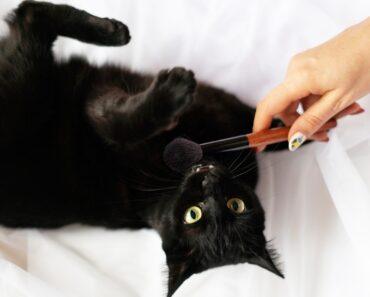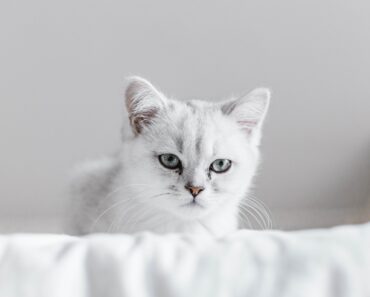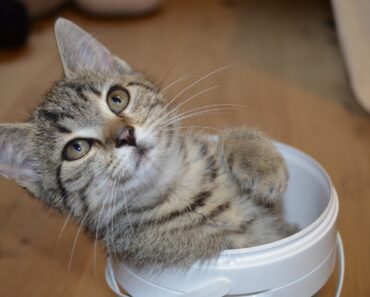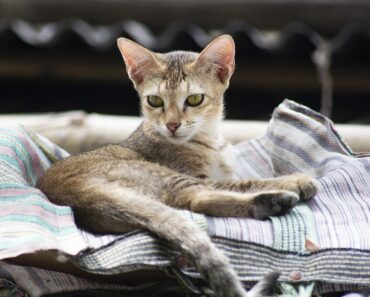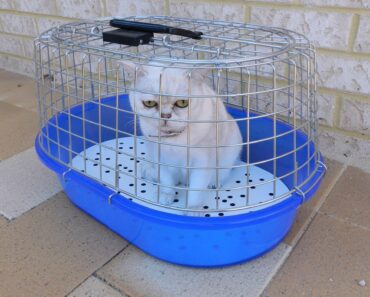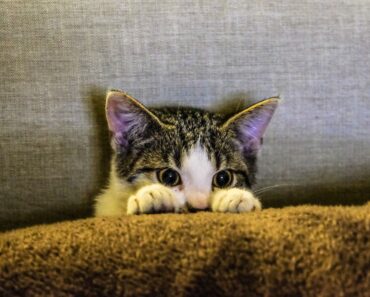Bald breeds are very striking and extremely fastidious pets. Their lack of fur makes them vulnerable to low temperatures and sunlight. They also have to use more resources to heat their bodies. For these reasons, the breeding and care of kittens and sphynx cats have a lot of peculiarities that the future owner should know.
What to buy before welcoming a bald kitten at home?
To begin with, you need to buy a basic kit, which is essential not only for a bald cat but also for all other cats. It includes:
- bowls for food and water;
- a litter box; and a litter scoop;
- a cat bed or litter box;
- toys ;
- hygiene products (veterinary toothpaste, ear cleaning lotion, grooming tools (toothbrush)
A special hammock that attaches to the radiator can be used instead of a regular cot. It will prevent the cat from getting cold and overheating by direct contact.
The other important point is safety. Kittens are very curious, so remove all small objects that can choke you (building materials, beads), household chemicals and electrical wires from the floor beforehand. Also consider checking houseplants for toxicity. Dangerous species should be eliminated.
Organize your sleeping space. Find a quiet place, away from noisy appliances and television. Avoid drafts and be sure to secure all windows with catches.
Skin care for the sphynx
Not having hair is a big advantage in terms of hair loss. A bald animal produces little dirt, but its skin is very delicate and requires careful care.
Skin characteristics of bald and partially bald cats
Sphynx skin is not protected by hair, so it is just as vulnerable to cold and sunlight as human skin. Bald cats are prone to cold and frequent colds. They love to bask in the sun’s rays, but they burn quite quickly.
Despite their lack of fur, bald cats are not a hypoallergenic breed. They sweat profusely and become covered in oily grease that leaves marks on furniture, bedding and clothing. If not washed regularly, their bodies will develop an unpleasant odor and an unhealthy yellow-brown tint. The most vulnerable area is the sweet spot. This is where pathogenic bacteria accumulate, causing dermatitis and other skin conditions.
Due to the more active sebaceous glands, black spots, or comedones, often form on the tail and chin of sphinxes.
Washing and application of cream
Nudges are washed once every 1 to 2 weeks when they are soiled. More frequent baths lead to the risk of flaking and dryness of the skin. This should be taught from an early age so that the animal is not stressed later.
For shampooing, use a shampoo specially designed for hairless breeds. It is gentle on the skin and suitable for sensitive skin. It is also recommended to get a conditioner and a soft sponge that will facilitate the application of detergent and the removal of dirt.
After bathing, carefully sponge and wrap your bald pet. Do not use a hair dryer, as the hot air can burn the delicate skin. Close all windows in your home until it is completely dry. This prevents the skin from catching a cold from a draft.
In addition to washing, you can and should use alcohol-free wet pet wipes or a soft, dampened cloth. These are handy for cleaning the folds of the skin.
To prevent flaking, you should always use a baby cream or special oil on your sphynx’s body. Olive oil and other vegetable oils are not suitable, as they create a thick film effect and clog the pores.
Another important point is the care of the ears. In hairless breeds, they are quite large and dirt and wax accumulate quickly. After each bath, be sure to clean the inside of the ears with a cotton ball.
The eyes are also vulnerable, as many breeds do not have eyelashes. Use cotton balls soaked in clear water for these as well.
Protection from the cold and sun: clothing choices
To protect your pet from hypothermia, keep the temperature in your home between 20 and 25°C. If this is not possible, use clothing. This, like bathing, should be taught from childhood.
“Noslings like to sleep under a blanket or plaid with their owners. If you are against sleepovers, forbid them from the start by getting the kitten used to a cot or kennel.
Prolonged exposure to sunlight is just as dangerous as excessive cooling. In the summer, it’s a good idea to put special sun protection film on windows.
If you plan to walk your cat, be sure to wear clothing and use SPF creams. When choosing the latter, it is important to consider the level of protection and the composition. It is safer to use creams for children. Before buying, always check that the following ingredients are not present:
- salicylates;
- zinc oxide;
- PABA, or para-aminobenzoic acid;
- Propylene glycol.
All of these products are toxic to animals and can cause serious consequences such as anemia, kidney and liver failure.
The skin of hairless breeds is warmer than that of furry breeds. Despite this, they still feel very cold, because the heat created by their bodies is dissipated rather than stored under the coat layer. That’s why “naked pets” feel like naked people in cold and high temperatures and also need clothes. When purchasing it, the following points should be considered:
- The quality of the fabric. Look for natural materials that do not electrify and do not contain chemical dyes. Also, don’t buy clothes that make noise or smell bad. Noises irritate the cat, while strong odors can cause allergies.
- Seam quality. Seams should be soft so they don’t rub on delicate skin. It is best to buy seamless models.
- Purpose of the garments. Lightweight t-shirts and sweaters are suitable for summer, and knitted sweaters, vests and fur jackets for winter. Choose wool items that don’t scratch, such as merino.
- Fittings. Velcro is the most comfortable type of fastener. Lace and ribbons are easy to confuse.
- Size. Before you buy the model you like, be sure to measure your pet. The most important measurements are back length and chest size.
Avoid styles that are too complex. The garment should not restrict your pet’s movement or contain small parts that it could swallow. It should not be worn on a regular basis either. At least twice a day, the animal should have the opportunity to lick itself.
Representatives need to be combed with fur
Sphynx kittens are often born with hair. Depending on the breed, the hair will fall out completely or partially within 1 to 2 years. The most hairy representatives are the brushes. Rare and short hairs, in the order of 2 to 4 mm, are also found in the herds and velvet. Externally, this coat is either a coarse, curly hair or a soft peach fuzz.
In most cases, the fleeces are not combed, but massaged with a special brush during washing. A normal comb is only needed for the hairy spindles. During the winter season, their hair becomes thicker and is therefore combed once a week with a short-tooth comb.
The health of bald cats
The average life expectancy of a sphynx is 10 to 12 years, but it can be extended with proper care. Prevention of diseases, to which all “bald cats” are prone, also plays an important role.
We must not forget their vulnerability to low temperatures. It is best not to take your pet outside during bad weather, because even if he wears clothes, he may catch a cold.
Deworming and vaccines
Even a brief weakening of defenses can lead to infection by viruses, bacteria and other pathogens. To avoid unpleasant consequences, fleas, like other breeds, should be regularly dewormed and vaccinated.
If an animal is kept indoors and does not go outside, it is administered twice a year. In other cases, quarterly use is recommended. Deworming is also indicated before vaccinations and foreign travel.
The first vaccination is given to kittens at the age of 2 to 2.5 months. At this age, they are vaccinated against panleukopenia, calcivirus and rhinotracheitis. After 15 to 30 days, another injection, or revaccination, is given. This consolidates the result and increases the amount of antibodies already produced after the first injection.
The last vaccination is against rabies. The animals are then vaccinated with a complete vaccine at one year intervals.
Characteristics of the diet
The last important point is diet. Hairless breeds have an increased metabolism, as they expend twice as much energy as furry breeds to heat their bodies. Their bodies need more calories and their stomachs need food all the time. But because of their habit of eating often and a lot, sphinxes often suffer from obesity.
Food Selection
When choosing foods, look for diets that are high in calories and low in carbohydrates. To avoid gaining too much weight, the cat must get most of its energy from protein. Also, don’t forget the importance of fat. Fat is responsible for the absorption of fat-soluble vitamins and the synthesis of certain hormones, and has a positive effect on skin quality.
The best option is to choose a food specially formulated for bare breeds. These ranges can be found in the rations of any manufacturer.
To calculate the daily ration, consider your pet’s weight and refer to the instructions on the package. If your pet is losing weight, the amount indicated can be increased. In other cases, begging should be ignored or treated by feeding more frequently without changing the daily ration.
Prohibited foods
Prohibited foods include all foods from the human table: spices, smoked foods, fried and fatty foods, pasta, pickles and sweets. The following foods are particularly dangerous:
- garlic and onions, which cause anemia;
- Sorrel, which can cause gastritis;
- berries and pome fruits, which can easily cause choking;
- Sultanas, grapes and mushrooms, which are toxic to pets;
- Raw pork and river fish, which often contain helminths;
- Millet, barley and some beans, which cause bloating and colic; and
- Semolina, pasta and baked goods, which cause rapid weight gain;
- Small, tubular bones, which often injure the esophagus and intestines with their sharp edges.
Milk is also contraindicated in all adult animals. This is due to lactose intolerance, which develops after the age of 4 months.
Conclusion
Before acquiring a new family member, make sure that you are prepared to take care of him. Sphinxes are very tedious and dependent pets that require a lot of attention. If you are intimidated by the number of requirements above, or simply don’t have the time, don’t make it difficult for yourself and choose a less problematic breed that you can certainly handle.
This article is just a guide!

